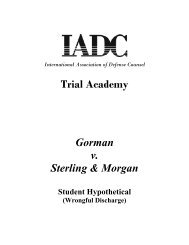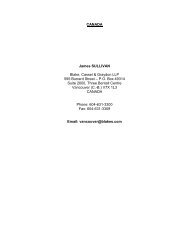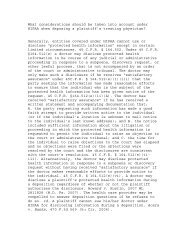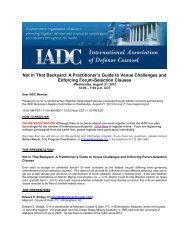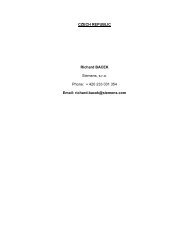Defense Counsel Journal - International Association of Defense ...
Defense Counsel Journal - International Association of Defense ...
Defense Counsel Journal - International Association of Defense ...
You also want an ePaper? Increase the reach of your titles
YUMPU automatically turns print PDFs into web optimized ePapers that Google loves.
Predictability In Punitive Damages Page 455consideration <strong>of</strong> the harm to nonparties. 2Over the past decade, the U.S. SupremeCourt has made numerous attempts toprovide more clarity to the calculation <strong>of</strong>punitive damage awards. Significantly,the Supreme Court suggested in ExxonShipping Co. v. Baker that a multiplierapproach may be the best way to decreasethe unpredictability <strong>of</strong> punitive damageawards. 3Although the idea <strong>of</strong> a punitivedamage multiplier has not yet beenwidely recognized, various courts andcommentators have considered the use <strong>of</strong>a multiplier to increase the efficiency <strong>of</strong>complex litigation. This article examinesthe possibility <strong>of</strong> having juries use apunitive damage multiplier to determinepunitive damages in class action or masstort litigation, paying particular attentionto the advantages and disadvantages <strong>of</strong> itsuse. In addition, this article will alsoanalyze the context in which courts haveutilized a multiplier approach and thecommon arguments presented by partiesin favor <strong>of</strong> and opposed to punitivedamage multipliers.I. Recent U.S. Supreme CourtPunitive Damage JurisprudenceThe most <strong>of</strong>ten cited rationaleunderlying punitive damage awards is thepublic function they serve: to punish anddeter behavior society deemsobjectionable, similar to the function <strong>of</strong>criminal punishments. 4 In order to2 Phillip Morris USA v. Williams, 549 U.S.346, 357 (2007).3 Exxon Shipping Co. v. Baker, 554 U.S. 471(2008).4 See Jill Wieber Lens, Punishing for theInjury: Tort Law’s Influence in Defining theachieve this goal, however, courts mustprovide for some predictability inpunitive awards. 5 Research on punitivedamage awards has revealed that a majorsource <strong>of</strong> unpredictability in how juriesdecide punitive damage awards “comesfrom the fact that people do not knowhow to ‘translate’ their moral judgmentsinto dollar amounts.” 6 In response, theU.S. Supreme Court has attempted toprovide guidance in calculating a punitiveaward that both meets the requirements <strong>of</strong>Due Process and provides the necessarypredictability for the award to fairly andadequately fulfill its function.In 2007, the Supreme Courtconsidered the Constitution’s DueProcess limitations with respect toawarding punitive damages in PhillipMorris U.S.A. v. Williams. 7 In PhillipMorris, the Court concluded that the DueProcess Clause forbids a state fromawarding punitive damages to punish adefendant for injuries to nonpartiesbecause such awards threaten punishmentfor conduct against which the defendantConstitutional Limitations on PunitiveDamage Awards, 39 HOFSTRA L. REV. 595,613-622 (2011) (discussing the United StatesSupreme Court’s emphasis on the state’sinterest in punitive damages and thesimilarities between punitive damages andcriminal punishments); see also ExxonShipping Co., 554 U.S. at 492 (“[T]heconsensus today is that punitives are aimednot at compensation but principally atretribution and deterring harmful conduct.”).5 Exxon Shipping Co., 554 U.S. at 499-500(declaring that “the real problem, it seems, isthe stark unpredictability <strong>of</strong> punitive awards”).6CASS R. SUNSTEIN, ET AL., PUNITIVEDAMAGES, HOW JURIES DECIDE, 29 (2002).7 Philip Morris, 549 U.S. 346 (2007).



